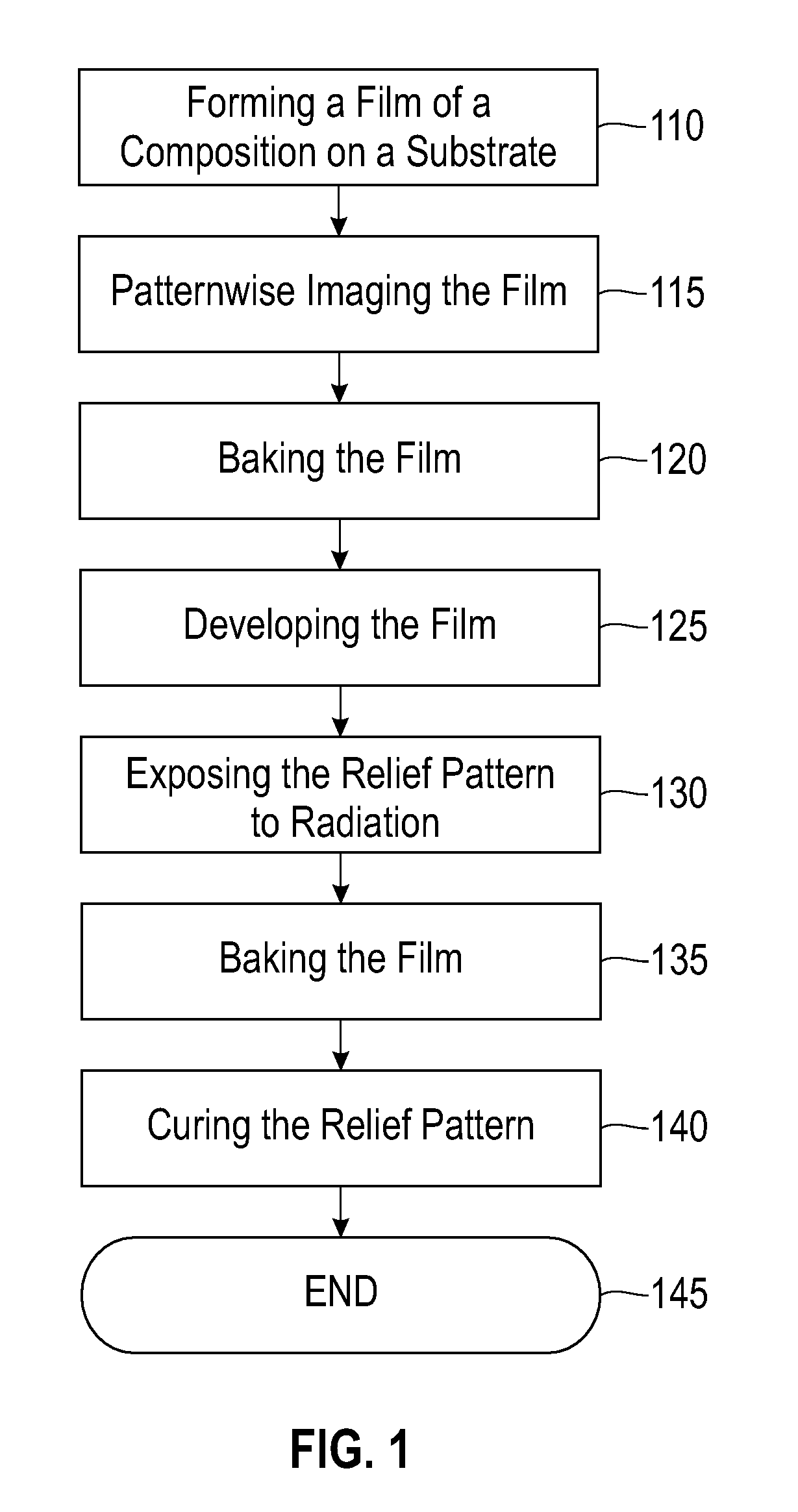Photopatternable dielectric materials for beol applications and methods for use
a dielectric material and dielectric technology, applied in the field of on-chip electrical insulators, can solve the problems of increasing signal delay in ulsi electronic devices, complex and inefficient process,
- Summary
- Abstract
- Description
- Claims
- Application Information
AI Technical Summary
Benefits of technology
Problems solved by technology
Method used
Image
Examples
example 1
Synthesis of Poly(4-hydroxy-α-methylbenzylsilsesquioxane-co-α-methylbenzylsilsesquioxane) (6:4 pHMBS / MBS).
[0066]A mixture of 1-trichlorosilyl-1-(4-acetoxyphenyl)-ethane (223.2 grams; 0.75 mole), 1-trichlorosilyl-1-phenyl-ethane (125.8 grams; 0.525.1 mole), and 389 grams (g) of anhydrous tetrahydrofuran were added drop-wise to a rapidly stirred mixture of triethylamine (307.7 g; 4.2075 mole) and 389 g of deionized water while cooling with an ice bath to maintain the reaction temperature between about 0° C. and about 10° C. After the addition was complete, the mixture was stirred at a temperature between about 0° C. and about 10° C., for one hour. The cooling bath was removed and the mixture was allowed to warm to room temperature and stir for about 20 hours. The reaction mixture was placed in a seperatory funnel and the lower layer was separated and retained. The upper layer was diluted with about 900 milliliters (ml) deionized water and extracted three times with about 450 ml of die...
example 2
Synthesis of Poly(4-tert-butylacetoxy-co-4-hydroxy-α-methylbenzylsilsesquioxane-co-α-methylbenzylsilsesquioxane) (1.2:4.8:4 pBAMBS / HMBS / MBS)
[0069]Poly(4-hydroxy-α-methylbenzylsilsesquioxane-co-α-methylbenzylsilsesquioxane) (5.0 g) and tert-butylbromoacetate (1.26 g, 6.5 millimoles) were dissolved in about 30 ml of acetone followed by the addition of K2CO3 (0.96 g, 6.9 millimoles). The reaction was stirred at ambient temperature for about 16 hours before the polymer was precipitated from about 2% aqueous acetic acid. The precipitate was filtered and dried overnight at about 40° C.
example 3
Photopatternable Blend Composition
[0070]A patternable low-k composition was formulated with 6 g of a 20 weight percent (wt %) solution of 1.2:4.8:4 pBAMBS / HMBS / MBS in propylene glycol monomethyl ether acetate (PGMEA), 4 g of a 20 wt % solution of the silsesquioxane polymer LKD-2056, 0.2 g of a 20 wt % solution of triphenylsulfonium nonaflate in PGMEA, and 0.2 g of a 0.5 wt % solution of a base in PGMEA. The resulting low-k formulation was filtered through a 0.2 micron (μm) filter.
PUM
| Property | Measurement | Unit |
|---|---|---|
| temperature | aaaaa | aaaaa |
| temperature | aaaaa | aaaaa |
| dielectric constant | aaaaa | aaaaa |
Abstract
Description
Claims
Application Information
 Login to View More
Login to View More - R&D
- Intellectual Property
- Life Sciences
- Materials
- Tech Scout
- Unparalleled Data Quality
- Higher Quality Content
- 60% Fewer Hallucinations
Browse by: Latest US Patents, China's latest patents, Technical Efficacy Thesaurus, Application Domain, Technology Topic, Popular Technical Reports.
© 2025 PatSnap. All rights reserved.Legal|Privacy policy|Modern Slavery Act Transparency Statement|Sitemap|About US| Contact US: help@patsnap.com



